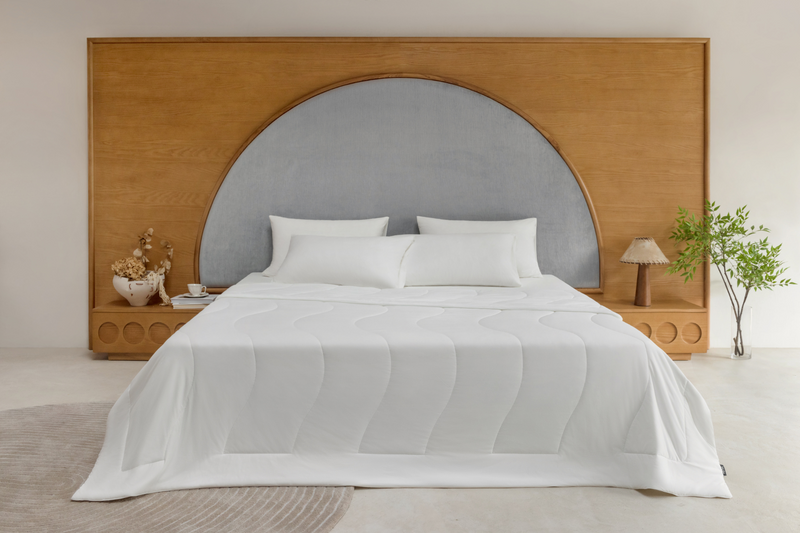Top 5 Best Bedding for Hot Sleepers in 2026
Hot weather can make it tough to get a good night’s sleep, especially if your mattress holds onto heat. One of the easiest ways to cool things down without investing in a new mattress is by switching to cooling bedding.
The right materials can make your bed feel more breathable and comfortable, even on warm nights. In this guide, we’ll explain the different types of cooling bedding and how they can help you sleep better.
Which Bedding Fabrics Help You Stay Cool?
To keep your sleep environment cooler, natural fibers are usually your best bet. They let air move freely and help prevent heat from building up around you. Cotton, in particular, does a great job of wicking away moisture, so you’re less likely to wake up feeling damp or sticky.
High-tech nylon is another option worth considering. It’s light, soft, and designed to pull moisture away from your skin while letting heat escape, ideal if you tend to sleep hot.
Wool, on the other hand, holds onto heat, so it’s better for cold nights. That said, some bedding blends wool with cotton to offer a nice balance, keeping you just warm enough while still managing moisture well.
Synthetic options can work too. Hollow fiber, for example, has tiny air pockets that help with airflow and reduce heat buildup. It’s a good alternative to down pillows and comforters if you’re looking for something breathable.
Some modern bedding even uses temperature-regulating materials like Outlast®, which absorbs and releases heat depending on your body temperature. That can help you stay comfortable through the night without major fluctuations.
Ultimately, the best fabric depends on how hot you sleep and what feels good to you.
Best Bedding for Hot Sleepers
1. Choosing Bed Sheets That Stay Cool
To keep your bed feeling comfortable on warm nights, go for sheets made from breathable fabrics. These materials allow air to move freely, helping you stay cooler and cutting down on night sweats. During hotter months, changing your sheets more often also helps everything feel fresher.
When it comes to color, lighter shades like white, beige, or pale gray are a smart choice. They reflect heat better than dark colors, which tend to hold onto warmth. Plus, light-colored sheets give your bed a clean, crisp look that feels more refreshing in summer.
Some cooling sheets also have helpful extras, like wrinkle-resistant finishes, so they stay smooth without fuss.
Switching to sheets designed for warm weather is a simple change that can make a big difference in how well you sleep, especially when the temperature climbs.
Best Pick: Evercool®+ Cooling Sheet Set

The Evercool®+ Cooling Sheet Set is made from a special breathable nylon that helps air move through and keeps moisture under control. That way, your bed feels fresh and comfortable all night.
These soft and smooth sheets are also designed to keep you cool and dry while you sleep. If you’re looking for bedding that feels great and helps with heat, the Evercool®+ set is a strong option.
Pros:
• Excellent breathability and airflow
• Moisture-wicking keeps you dry
• Soft and smooth feel
• Durable and easy to care for
Cons:
• Higher price point than basic cotton sheets
• Some may prefer natural fibers over synthetic nylon
2. Pillows Designed to Stay Cool
If you like your pillow to feel cool when lying down, there are a few great options to consider. Some pillows have built-in cooling features like gel pads, which use tiny gel beads to absorb and pull away heat so the pillow stays cooler through the night.
Cool gel foam pillows work similarly; they help regulate temperature while offering a bit more support. If you’re after something lighter, “summer” pillows are a good option. They don’t actively cool, but their lower density allows for better airflow, which helps you stay more comfortable.
Hollow fiber is another solid pick. It’s soft like down, breathes well, and usually costs less. You get a nice balance of comfort and coolness without breaking the bank.
Best Pick: Evercool Cooling Pillow

The Evercool® Cooling Pillow from Rest is a solid choice if you often get hot at night or deal with night sweats. It’s made to stay cool all night long, helping you sleep more comfortably. What makes it stand out is how it combines cooling with good support for your head and neck. It feels comfortable without losing that cooling effect.
Plus, it’s easy to clean and maintain. It’s a bit pricey, but this one might be worth it if you’re tired of constantly flipping your pillow looking for a cooler spot. For many people, the improved comfort and better sleep make it a good investment.
Pros:
• Keeps pillow surface cool all night
• Breathable and moisture-wicking cover
• Lightweight yet supportive
• Helps reduce night sweats
Cons:
• May feel firmer than traditional down pillows
• Pricier than standard pillows
3. Cooling Comfort with Lightweight Duvets and Quilts
If you want to stay cool during warm nights, go for duvets with a low tog rating, around 4.5 is ideal. The tog number tells you how much warmth the duvet holds, so a lower rating means it won’t trap as much heat.
Some duvets also use cooling tech with special microfibers that promote airflow and help heat dissipate as you sleep.
Choose covers made from breathable microfiber that feel soft and let moisture escape. This keeps you comfortable and fresh, especially if you tend to sweat on hot summer nights.
Best Pick: Evercool®+ Comforter

The Evercool® Cooling Comforter is light and breathable, perfect if you want cozy without getting too hot. Its special fabric helps manage your body temperature so you stay cool on warm nights and comfortably warm when it’s cooler.
Because it strikes that balance, it works well across different seasons and for all kinds of sleepers. If you want a comforter that adjusts to your needs without feeling heavy or bulky, it is the one for you.
Pros:
• Lightweight and breathable materials
• Moisture-wicking properties
• Easy to wash and quick-drying
Cons:
• Not suitable for cold weather without additional layers
• Cost is higher than basic comforters
4. Cooling Mattress Pads for a Cooler Sleep
You can easily remove cooling mattress pads whenever you want a warmer bed. These pads use special materials that draw heat away from your body to help keep you cooler.
Many cooling pads use gel-infused foam or graphite strips to soak up and spread heat. Others use open-cell foam that lets air flow naturally, keeping the surface fresh.
If you tend to get too warm at night, adding a cooling mattress pad can really help make your sleep more comfortable.
Best Pick: Sleep Innovations Gel Memory Foam Mattress Topper
This topper is made with gel-infused memory foam that helps draw heat away from your body, keeping you cool and comfortable. It adds a soft layer of support and is designed to let air flow through, so heat doesn’t build up while you sleep. Plus, it molds to your shape for a comfy, personalized feel, making it a great way to upgrade your bed for cooler, better rest.
Pros:
• Effective cooling with gel infusion
• Adds comfort and pressure relief
• Removable and washable cover
Cons:
• Can retain some heat depending on room temperature
• Slight initial odor when new
5. Cooling Mattress Covers for Better Sleep
You can make your sleep setup more comfortable with a cooling mattress cover that helps control heat and moisture. These covers usually use breathable fabrics like cotton or linen, which allow air to flow and help keep allergens at bay.
If you tend to sweat at night, a cooling mattress cover can keep your bed feeling fresh and clean. It’s also a helpful option if you deal with temperature changes from menopause or other health issues.
Best Pick: PureCare UltraFresh Mattress Protector
This mattress protector is made from breathable cotton terry fabric and features moisture-wicking technology to help keep you cool and comfortable. It also guards against allergens and spills. The soft feel against your skin adds to a better night’s sleep, and it’s built to last while being easy to clean, making it a convenient option for daily use.
Pros:
• Breathable, natural fabric
• Waterproof and allergen-resistant
• Quiet, doesn’t crinkle like plastic covers
Cons:
• May be pricier than basic protectors
• Some users find it slightly less stretchy
How to Choose the Right Cooling Bedding for You

Picking the right cooling bedding isn’t just about grabbing the most expensive or the latest tech. It’s about what fits your sleeping style, budget, and comfort preferences. Here’s a quick guide to help you decide:
-
Think about how hot you actually get: If you just feel warm occasionally, breathable cotton sheets might do the trick. But if you regularly wake up sweating, look for moisture-wicking fabrics like specialized nylon blends or gel-infused pillows.
-
Consider your budget: Cooling bedding can range from affordable basics to premium sets with advanced materials. Set a price range first, then look for the best cooling features within that range.
-
Know your comfort needs: Do you like soft and fluffy pillows or firmer support? Are you sensitive to synthetic fabrics or prefer natural fibers? Make sure to pick something that feels good against your skin.
-
Consider maintenance: Some cooling bedding needs special care, like gentle washing or air drying, to keep working well. If you want low fuss, look for options that are machine washable and durable.
-
Climate matters: If you live somewhere hot year-round, prioritize breathability and moisture control. If it only gets warm seasonally, a lightweight comforter or cooling mattress pad you can add or remove might work better.
Taking a little time to figure out these details will save you from spending on something that doesn’t really meet your needs. And remember, you can mix and match—cool sheets with a gel pillow or a lightweight comforter—to get the best sleep.
FAQs about Cooling Bedding

1. Do cooling sheets really work?
Yes, they do, but it depends on the material. Cooling sheets made from breathable, moisture-wicking fabrics help regulate your temperature by allowing air to circulate and pulling sweat away from your skin. They won’t magically make your room cooler, but they can make your bed feel much more comfortable on hot nights.
2. Can cooling bedding help with night sweats caused by menopause?
Absolutely. Night sweats during menopause happen because of body temperature fluctuations, and cooling bedding can help manage that by keeping moisture away and allowing heat to escape. It won’t cure night sweats, but it can reduce discomfort and help you sleep better.
3. Are synthetic fabrics better than natural ones for cooling?
Both have pros and cons. Natural fabrics like cotton breathe well and feel soft, but some synthetic options are specially designed to wick moisture and dry faster. If you’re sensitive to chemicals or prefer natural fibers, cotton or linen might be best. If you want extra moisture control, some synthetic blends can perform better.
4. How often should I replace my cooling bedding?
That depends on how often you use it and how well you care for it. High-quality cooling sheets and pillows can last several years if properly maintained, but signs like loss of breathability, pilling, or reduced comfort mean it’s time to replace them.







